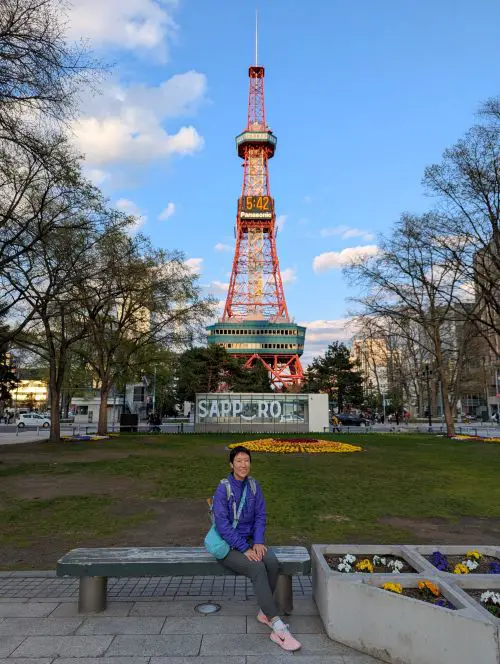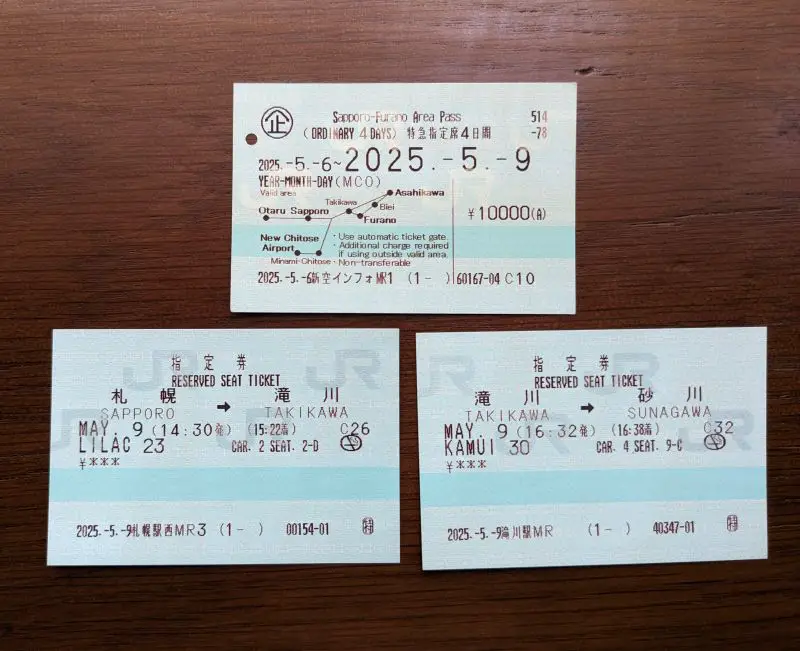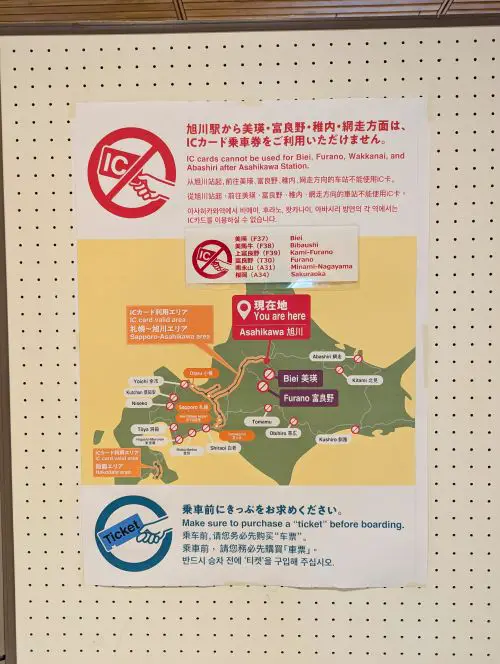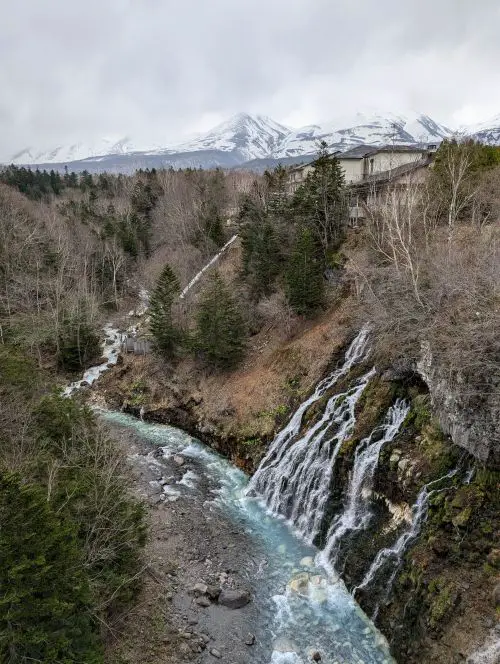If you plan to visit Japan’s Hokkaido region and want to use trains as the main source of transportation, consider getting a Japan Railways Pass (JR Pass).
There are 3 rail passes to use in Hokkaido: the Hokkaido Line, the Sapporo-Furano Area, and the Sapporo-Noboribetsu Area. The destinations for each pass vary.
Since it was our first time visiting Hokkaido, Justin and I decided to go for the JR Sapporo-Furano Area Pass for 4 days. We wanted to explore Otaru, Asahiyama, and Biei, which are included in this pass. We didn’t have enough time to maximize the All Hokkaido Line pass.
After using many regional JR passes during our Japan travels, we can say that this pass is worth the value and super convenient to use.
If you’re interested in learning more, let’s keep going. We’ll share the pros and cons of using the JR Sapporo- Furano Area Pass, what’s included, and our itinerary.
*Disclaimer: This post contains affiliate links. If you click on them and make a purchase, we receive a small commission. There is no additional cost to you. Appreciate the support.
Quick Pros/Cons of JR Hokkaido Sapporo-Furano Rass
Don’t have time to read the post? Here is a quick snapshot of the top reasons and things to consider about the train pass.
Pros
- Easy and convenient to use.
- The pass includes JR local, limited express, and rapid train within the designated Sapporo-Furano areas.
- Unlimited reserved seating for certain train lines.
Cons
- Plan your itinerary in advance.
- Shinkansen (high-speed bullet trains) or buses cannot be used with the pass.
- Pass must be used in consecutive 4 days.
Benefits of the Pass (Pros)
Explore Hokkaido’s Sapporo and Furano area.
It was our first time visiting Hokkaido, so we wanted to get an introduction to Sapporo and the neighboring areas.
With this pass, you have unlimited travel from New Chitose Airport to the popular cities – Sapporo, Otaru, Asahikawa, Biei, and Furano. You can also visit the smaller cities along the train lines.
We ended up going to the places listed above and smaller cities, except Furano. Since we visited in May 2025, it was towards the end of the cherry blossom season. Since Furano is known for the rosemary fields, it wasn’t the right season to visit. So, we will return to Furano on a future trip.

I am sitting in front of the Sapporo Tower at sunset
Save money with this pass.
We recommend creating a rough itinerary for where to go along the Sapporo to Furano lines.
Then, use the JR Hokkaido Timetable and Ticket Price Search to input the starting and ending train stations and see the fare cost. You can see the regular fare and reserved fare.
Then, determine if the pass is worth it over the four days.
Here are examples of where we went:
Trip 1: We went from JR Sapporo to JR Asahikawa Station.
- Amount of time: 1.5 hour one-way
- One-way cost: 3,080 yen for a regular seat (non-reserved); 5,440 yen for a reserved seat (for Adults)
- Round trip cost: 6,160 yen for non-reserved; 10,880 yen for reserved
Trip 2: We went from Sapporo to Otaru Station.
- Amount of time: 35 minute ride one-way
- One-way cost: 800 yen for regular seat (non-reserved); 1,640 yen for a reserved seat (for Adults)
- Round trip cost: 1,600 yen non-reserved; 3,280 yen for reserved
Our Verdict: With these two trips with reserved seats, you’ve already exceeded the value of the pass (11,000 yen for adults). After tallying up our rides, we spent around 27,000 yen in 4 days. So, the pass saved us tons of money!
Allows you to take local, limited express, and rapid trains in the area.
Taking the limited express and rapid trains will expedite the transportation time as the route skips stations.
TIP: If you’re not sure which train to take, you can use Google Maps to input your starting and ending locations and see what Google Maps suggests.
Reserve your seats!
One of the major perks of this pass is that you can reserve seats in advance for your train rides. This includes the Limited Express and Rapid trains. You can have an unlimited number of seat reservations within your pass validity.
There are two ways to reserve seats.
- The easiest way: Visit the JR Ticket Counter and tell the ticket agent where you’re going and the time of departure. If you need a seat immediately, then look on the screen for the next available train going to your destination. You can also reserve for the next day.
- The independent way: Use the Reservation ticket machines. Read this PDF with instructions on how to reserve the seats.
We reserved seats for the Rapid/Semi-Rapid Airport and Lilac and Kamui Limited Express Trains. We used both the in-person reservation at the counter and the reservation machine.
NOTE: Some of the train lines have only one non-reserved car, so it’s better to have a reservation in advance. You need a reserved seating ticket and your JR pass to sit in the section.

Here is the physical ticket of the JR Sapporo Furano Area Pass and two reserved seating tickets that we received
Save time with the pass.
Most people tend to buy a ticket or use an IC transportation card, such as Suica, Pasmo, ICOCA, etc. to travel around Japan.
But we saw signage that IC cards are not accepted in certain areas of Hokkaido. So, a ticket will need to be purchased in advance. Check out this photo below.

Beware of the areas where IC cards are not accepted, so a ticket must be purchased.
So, having this pass eases the extra step of buying a ticket with cash.
Things to Consider About the Pass (Cons)
Calculate if the pass is worth the price.
As mentioned in the section below, it’s highly recommended to create a plan on where you’ll go.
Then you can use the JR Hokkaido Timetable and Ticket Price Search to calculate the train cost and whether you’ll break even or exceed the pass value over the 4 days.
If you don’t plan to travel far and only stay within Sapporo City, then the pass will not be worth the value. You can use an IC transportation card or buy a ticket to travel within the city.
You can only use this pass in the designated Sapporo-Furano area.
The JR Sapporo-Furano pass has a map on the ticket on which train lines you can take. If you take a train line that is outside of the map area, then you’ll need to pay an adjustment fee.
This pass does not allow you to go to Niseko, Hakodate, Noboribetsu, Kushiro, Abashiri, or even local lines such as Hokkaido-Iryodaigaku or Iwamizawa.
Therefore, you’ll need to consider other JR passes, such as the JR Hokkaido Line or Sapporo-Noboribetsu, to visit these areas. The cost of the pass will vary depending on duration.
Also, you cannot travel to Hokkaido from Tokyo (or the neighboring prefectures) as this requires a Shinkansen train. If you want to take the Shinkansen from Tokyo, then consider the JR East South Hokkaido or the JR Whole Japan Rail Pass (to access the entire country).
The pass does not cover Shinkansens (high-speed bullet trains) or JR Hokkaido buses.
If you want to use any Shinkansens, you’ll need to pay out of pocket. In addition, the Shinkansen line doesn’t stop by the Asahikawa or Furano area. Here is more information about the Hokkaido Shinkansen line.
Unfortunately, the JR Hokkaido Bus in Sapporo City is not covered by the pass. But you can pay out of pocket for the rides.
You need to use this pass on 4 consecutive days.
JR passes do not allow for breaks between the pass usage. If you need a break between the pass, then you will need to adjust your itinerary and/or not buy the pass.
Cost
- Adults: 11,000 yen (There was a price increase in April 2025. The pass used to cost 10,000 yen).
- Children (6-11 years): 5,500 yen
Where to Buy the Pass
Buy the pass directly from an approved third-party vendor, such as Klook, or through the official JR East Reservation Website.
We love using Klook for our Japan trips and have bought JR passes before. We haven’t had any issues with purchasing and redeeming the vouchers.
For the Sapporo-Furano Pass, we used Klook to buy this pass in March 2025 before the price increase in April 2025. Compared to other JR passes that we’ve ordered, we received an e-voucher in my email. So, you don’t need to wait for a physical voucher in the mail.
This voucher needs to be redeemed at a JR Ticket Office, such as at New Chitose Airport, within 90 days of purchase. Then you’ll receive your physical pass that you can use at the station’s turnstiles.
How to Get Your Physical Pass
Step 1: Buy the pass online and receive an e-voucher. You can buy on the JR East website or from a third-party vendor, such as Klook. We bought this exact pass on Klook.
Step 2: Print your e-voucher.
Note: I read that people can show an e-copy of the voucher on their phones. I haven’t tried it yet, as I know it’s easier for the Ticket Agent to see a piece of paper than a screen.
Step 3: Redeem your e-voucher at a JR ticket office, such as New Chitose Station or Sapporo Station. Each person receiving the pass needs to show a passport.
Step 4: Receive a light green train ticket with the start and end date and insert it at the turnstiles. Do not lose the ticket.
Step 5: You may reserve seats with the JR ticket agent for the same day or the next day.
Where We Traveled With the Pass
We stayed in Sapporo and departed from Sapporo Station to travel around. We’ll have more posts on each of these locations soon!
Day 1 – Activated the pass. Took the non-reserved Airport train line from New Chitose Airport to Chitose. We picked up a manhole cover card from Chitose and then took the non-reserved Airport train line to Sapporo. We explored the city center of Sapporo.
Day 2 – Traveled to Otaru and visited the Canal and Otaru Aquarium.
Day 3 – Went to Asahiyama and took the local train to Biei. We went to Biei’s Blue Pond and the Shirahige Waterfall.

We visited Biei to see this lovely Shirahige Waterfall
Day 4 – We spent the day collecting manhole cards and seeing a few Pokémon manhole covers. We traveled to many cities – Eniwa, Kita Hiroshima, Ebetsu, Takikawa, and Sunagawa. We used both reserved and non-reserved seating for the trains. We also needed to jog and run to visit the card locations since it would have taken too long to walk to each place.
Final Thoughts
We enjoyed using the pass to explore Sapporo, Asahikawa, Biei, Otaru, and other cities. The four days went quickly, so we were glad to use the trains to travel between the cities. We recommend this pass and would buy the JR Sapporo Furano Area Pass again when we’re traveling in Hokkaido.
If you have any questions about this pass, please ask a question in the comment section below.
Check out our other Japan train passes that we’ve written about:
Like this post? Save it to your Japan Travels Pinterest Board.


